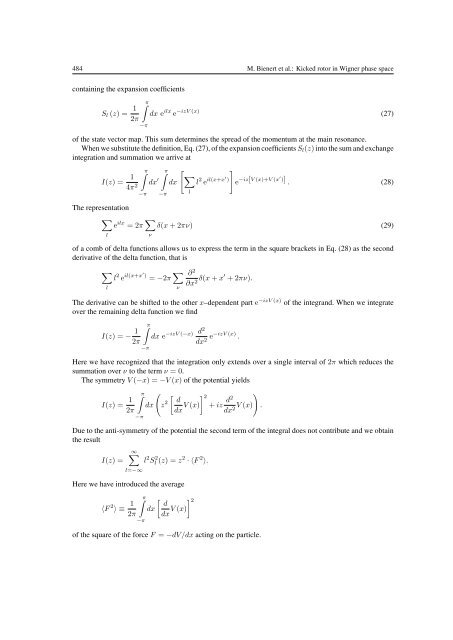Kicked rotor in Wigner phase space - The University of Texas at Austin
Kicked rotor in Wigner phase space - The University of Texas at Austin
Kicked rotor in Wigner phase space - The University of Texas at Austin
You also want an ePaper? Increase the reach of your titles
YUMPU automatically turns print PDFs into web optimized ePapers that Google loves.
484 M. Bienert et al.: <strong>Kicked</strong> <strong>rotor</strong> <strong>in</strong> <strong>Wigner</strong> <strong>phase</strong> <strong>space</strong><br />
conta<strong>in</strong><strong>in</strong>g the expansion coefficients<br />
Sl (z) = 1<br />
π<br />
2π<br />
−π<br />
dx e ilx −izV (x)<br />
e<br />
<strong>of</strong> the st<strong>at</strong>e vector map. This sum determ<strong>in</strong>es the spread <strong>of</strong> the momentum <strong>at</strong> the ma<strong>in</strong> resonance.<br />
When wesubstitutethedef<strong>in</strong>ition, Eq. (27), <strong>of</strong> theexpansion coefficients Sl(z) <strong>in</strong>to thesum and exchange<br />
<strong>in</strong>tegr<strong>at</strong>ion and summ<strong>at</strong>ion wearrive<strong>at</strong><br />
I(z) = 1<br />
4π2 π<br />
−π<br />
dx ′<br />
π<br />
−π<br />
dx<br />
<br />
l<br />
l 2 e il(x+x′ )<br />
(27)<br />
<br />
e −iz[V (x)+V (x′ )] . (28)<br />
<strong>The</strong> represent<strong>at</strong>ion<br />
<br />
e ilx =2π <br />
δ(x +2πν) (29)<br />
l<br />
ν<br />
<strong>of</strong> a comb <strong>of</strong> delta functions allows us to express the term <strong>in</strong> the square brackets <strong>in</strong> Eq. (28) as the second<br />
deriv<strong>at</strong>ive<strong>of</strong> thedelta function, th<strong>at</strong> is<br />
<br />
l 2 e il(x+x′ <br />
)<br />
= −2π<br />
l<br />
ν<br />
∂ 2<br />
∂x 2 δ(x + x′ +2πν).<br />
<strong>The</strong>deriv<strong>at</strong>ivecan beshifted to theother x–dependent part e −izV (x) <strong>of</strong> the<strong>in</strong>tegrand. When we<strong>in</strong>tegr<strong>at</strong>e<br />
over the rema<strong>in</strong><strong>in</strong>g delta function we f<strong>in</strong>d<br />
I(z) =− 1<br />
π<br />
2π<br />
−π<br />
−izV (−x) d2<br />
dx e<br />
dx2 e−izV (x) .<br />
Here we have recognized th<strong>at</strong> the <strong>in</strong>tegr<strong>at</strong>ion only extends over a s<strong>in</strong>gle <strong>in</strong>terval <strong>of</strong> 2π which reduces the<br />
summ<strong>at</strong>ion over ν to theterm ν =0.<br />
<strong>The</strong>symmetry V (−x) =−V (x) <strong>of</strong> the potential yields<br />
I(z) = 1<br />
π<br />
<br />
dx z<br />
2π<br />
2<br />
−π<br />
2 d<br />
V (x)<br />
dx<br />
+ iz d2<br />
<br />
V (x) .<br />
dx2 Dueto theanti-symmetry <strong>of</strong> thepotential thesecond term <strong>of</strong> the<strong>in</strong>tegral does not contributeand weobta<strong>in</strong><br />
theresult<br />
I(z) =<br />
∞<br />
l=−∞<br />
l 2 S 2 l (z) =z 2 ·〈F 2 〉.<br />
Herewehave<strong>in</strong>troduced theaverage<br />
〈F 2 〉≡ 1<br />
π<br />
2 d<br />
dx V (x)<br />
2π dx<br />
−π<br />
<strong>of</strong> thesquare<strong>of</strong> theforceF = −dV/dx act<strong>in</strong>g on theparticle.
















